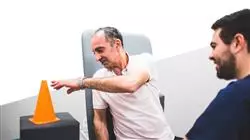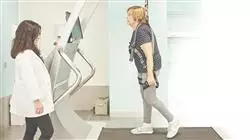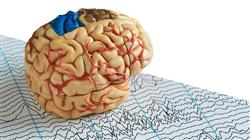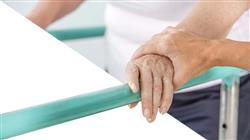University certificate
The world's largest faculty of physiotherapy”
Why study at TECH?
You are going to move up the career ladder and bring smiles back to your patients faces with neurological rehabilitation in line with their ailments"

Neurological conditions can be of all types. From disorders such as hemiplegia, ataxia or hydrocephalus, to cranioencephalic trauma or spinal cord injuries, the therapeutic professional must have a deep knowledge of all these pathologies in order to be able to offer the best possible treatment and rehabilitation.
Being such a specific area of rehabilitation, it is also a great opportunity for professionals to specialize in a field that is in demand and requires high qualification. With the population aging more and more rapidly and exponentially, it is more common to find age-related neurological diseases, so more neurological physiotherapists will be required to have the advanced training necessary to perform the treatments.
As Neurological Physical Therapy focuses on the nervous system, the student will learn the most up-to-date knowledge in the branches of motor control and neuroplasticity, as well as advanced motor learning techniques with which to develop effective rehabilitation plans. The teaching team responsible for writing this content is of the highest level, as their extensive professional experience guarantees the adequacy of the didactic material to the most rigorous clinical knowledge and techniques.
Therefore, TECH has combined in this program the most essential and up-to-date theoretical contents with the most effective Hybrid professional master’s degree, so that the student has the best possible understanding of Neurological Physiotherapy. Thanks to the professionalism of the faculty and tutors, the student has the best educational guide to grow professionally and personally towards a physiotherapeutic field where they can obtain great recognition by helping patients with more delicate situations.
Combine the convenience of online study with expert training that will help you achieve your goals"
This Hybrid professional master’s degree in Neurological Physiotherapy in Degenerative Diseases contains the most complete and up-to-date scientific program on the market. The most important features include:
- Development of more than 100 clinical cases presented by neurological physiotherapists of the highest level, with extensive experience in the treatment of all types of conditions
- Its graphic, schematic and eminently practical contents with which they are conceived, collect scientific and healthcare information on those medical disciplines essential for professional practice
- Combination of theory and physiotherapy practice for a comprehensive understanding of all content
- Detailed and illustrated explanation of the most innovative therapeutic rehabilitation processes, used in the most prestigious clinics
- Teaching staff of high academic level, with extensive experience in the treatment of patients with neurological pathologies
- Stimulating learning in which the student’s transversal skills in terms of organization and proactivity are developed
- Comprehensive study of the main neurological conditions in today’s patients
- All this will be complemented with theoretical lessons, questions to the expert, discussion forums on controversial topics and individual reflection work
- Content that is accessible from any fixed or portable device with an Internet connection
- Addition, you will be able to do a clinical internship in one of the best hospital centers
You are at the best possible time to direct your career towards neurological physical therapy by pursuing this TECH program"
In this Professional Master's Degree proposal, of a professionalizing nature and blended learning modality, the program is intended to update nursing professionals who develop their functions in high performance centers, clinical or hospital centers, and who require a high level of qualification. The content is based on the latest scientific evidence and is organized in a didactic way to integrate theoretical knowledge into nursing practice. The theoretical-practical elements allow professionals to update their knowledge and help them to make the right decisions in patient care.
The multimedia content developed with the latest educational technology will provide the professional with situated and contextual learning, i.e., a simulated environment that will provide an immersive education program to learn in real situations. This program's design is based on Problem Based Learning, by means of which the student must try to solve different professional practice situations that will be presented throughout the program. For this purpose, the student will be assisted by an innovative interactive video system created by renowned experts.
You will learn in the best possible way how to carry out innovative rehabilitation plans, focused on the neurological recovery of your patients"

Make your resume much more attractive to go even further in your healthcare career towards the most prestigious positions"
Temario
A lo largo de todo el temario, el fisioterapeuta ahondará en las patologías neurológicas más importantes, incluyendo módulos dedicados a las enfermedades neurodegenerativas, esclerosis múltiple, enfermedad de Huntington, Alzheimer y tumores del sistema nervioso. Todo ello bajo una perspectiva eminentemente práctica, incluyendo numerosos casos clínicos reales para que la contextualización y posterior introducción en una clínica fisioterapéutica sea mucho más eficiente.

Contamos con el programa científico más completo y actualizado del mercado. Queremos poner a tu alcance el mejor Hybrid professional master’s degree”
Módulo 1. Introducción a las enfermedades neurodegenerativas
1.1. Introducción
1.1.1. Definición
1.1.2. Clasificación
1.1.3. Epidemiología
1.2. Clínica/Síntomas
1.2.1. Síntomas
1.2.2. Signos
1.2.3. Diagnóstico por imagen (estructural y funcional)
1.3. Escalas de valoración y calidad de vida
1.3.1. Impacto psicosocial de las enfermedades neurodegenerativas y calidad de vida
1.3.2. Escalas
1.4. Exploración neurológica
1.4.1. Tono, sensibilidad, reflejos osteotendinosos y reflejos patológicos
1.4.2. Exploración: tronco, miembro superior (función de apoyo, alcance y manipulación), miembro inferior (bipedestación estática y dinámica)
1.4.3. Coordinación, equilibrio y marcha
1.4.4. Trastornos cognitivos
1.4.5. Pares craneales
1.5. Equipo multidisciplinar
1.5.1. Modelos de trabajo en equipo en neurorehabilitación
1.5.2. Componentes del equipo en neurorehabilitación
1.6. Abordaje desde la fisioterapia
1.6.1. Técnicas de facilitación del movimiento
1.6.2. Ejercicio terapéutico
1.6.3. Neurodinamia aplicada
1.7. Otros métodos
1.7.1. Hidroterapia
1.7.2. Terapia asistida con animales
1.7.3. Robótica y realidad virtual
1.8. Complicaciones del paciente
1.8.1. Dolor
1.8.2. Complicaciones aparato cardio-respiratorio
1.8.3. Complicaciones músculo-esqueléticas
1.8.4. Edema linfático y úlceras por presión
1.8.5. Otras
1.9. Información y asesoramiento del paciente, cuidador y de la familia
1.10. Fisioterapia digital y realización de informes
1.10.1. Telefisioterapia
1.10.2. Consulta programada mediante TIC
1.10.3. Redacción de informe de fisioterapia
1.10.4. Interpretación de informe médico
Módulo 2. Enfermedad de Parkinson y otras enfermedades neurodegenerativas relacionadas (parálisis supranuclear progresiva, degeneración corticobasal, atrofia multisistémica)
2.1. Introducción
2.1.1. Anatomía
2.1.2. Fisiología
2.1.3. Clasificación
2.1.4. Epidemiología
2.2. Etiología
2.2.1. Modo de transmisión
2.2.2. Frecuencia
2.2.3. Edad de comienzo
2.3. Evolución/Factores pronóstico
2.4. Diagnóstico
2.4.1. Manifestaciones clínicas
2.4.2. Diagnóstico por imagen
2.5. Evaluación
2.5.1. Exploración neurológica
2.5.2. Escalas de valoración
2.6. Tratamiento
2.6.1. Médico-quirúrgico
2.6.2. Terapia Ocupacional, logopedia y neuropsicología
2.7. Tratamiento de fisioterapia
2.8. Ortopedia
2.8.1. Productos de apoyo
2.8.2. Ortesis
2.9. Readaptación
2.9.1. Aspectos sociales/apoyo social
2.9.2. Atención integral a pacientes, familiares/cuidadores
2.10. Prevención y detección precoz
Módulo 3. Esclerosis múltiple
3.1. Introducción
3.1.1. Anatomía
3.1.2. Fisiología
3.1.3. Clasificación
3.1.4. Epidemiología
3.2. Etiología
3.2.1. Modo de transmisión
3.2.2. Frecuencia
3.2.3. Edad de comienzo
3.3. Evolución/Factores pronóstico
3.4. Diagnóstico
3.4.1. Manifestaciones clínicas
3.4.2. Diagnóstico por imagen
3.5. Evaluación
3.5.1. Exploración neurológica
3.5.2. Escalas de valoración
3.6. Tratamiento
3.6.1. Médico-quirúrgico
3.6.2. Terapia Ocupacional, logopedia y neuropsicología
3.7. Tratamiento de Fisioterapia
3.8. Ortopedia
3.8.1. Productos de apoyo
3.8.2. Ortesis
3.9. Readaptación
3.9.1. Aspectos sociales/apoyo social
3.9.2. Atención integral a pacientes, familiares/cuidadores
3.10. Prevención y detección precoz
Módulo 4. Esclerosis lateral amiotrófica
4.1. Introducción
4.1.1. Anatomía
4.1.2. Fisiología
4.1.3. Clasificación
4.1.4. Epidemiología
4.2. Etiología
4.2.1. Modo de transmisión
4.2.2. Frecuencia
4.2.3. Edad de comienzo
4.3. Evolución/Factores pronóstico
4.4. Diagnóstico
4.4.1. Manifestaciones clínicas
4.4.2. Diagnóstico por imagen
4.5. Evaluación
4.5.1. Exploración neurológica
4.5.2. Escalas de valoración
4.6. Tratamiento
4.6.1. Médico-quirúrgico
4.6.2. Terapia Ocupacional, logopedia y neuropsicología
4.7. Tratamiento de Fisioterapia
4.8. Ortopedia
4.8.1. Productos de apoyo
4.8.2. Ortesis
4.9. Readaptación
4.9.1. Aspectos sociales/apoyo social
4.9.2. Atención integral a pacientes, familiares/cuidadores
4.10. Prevención y detección precoz
Módulo 5. Enfermedad de Huntington
5.1. Introducción
5.1.1. Anatomía
5.1.2. Fisiología
5.1.3. Clasificación
5.1.4. Epidemiología
5.2. Etiología
5.2.1. Modo de transmisión
5.2.2. Frecuencia
5.2.3. Edad de comienzo
5.3. Evolución/Factores pronóstico
5.4. Diagnóstico
5.4.1. Manifestaciones clínicas
5.4.2. Diagnóstico por imagen
5.5. Evaluación
5.5.1. Exploración neurológica
5.5.2. Escalas de valoración
5.6. Tratamiento
5.6.1. Médico-quirúrgico
5.6.2. Terapia Ocupacional, logopedia y neuropsicología
5.7. Tratamiento de fisioterapia
5.8. Ortopedia
5.8.1. Productos de apoyo
5.8.2. Ortesis
5.9. Readaptación
5.9.1. Aspectos sociales/apoyo social
5.9.2. Atención integral a pacientes, familiares/cuidadores
5.10. Prevención y detección precoz
Módulo 6. Enfermedades neuromusculares y polineuropatías
6.1. Introducción
6.1.1. Anatomía
6.1.2. Fisiología
6.1.3. Clasificación
6.1.4. Epidemiología
6.2. Etiología
6.2.1. Modo de transmisión
6.2.2. Frecuencia
6.2.3. Edad de comienzo
6.3. Evolución/Factores pronóstico
6.4. Diagnóstico
6.4.1. Manifestaciones clínicas
6.4.2. Diagnóstico por imagen
6.5. Evaluación
6.5.1. Exploración neurológica
6.5.2. Escalas de valoración
6.6. Tratamiento
6.6.1. Médico-quirúrgico
6.6.2. Terapia Ocupacional, logopedia y neuropsicología
6.7. Tratamiento de fisioterapia
6.8. Ortopedia
6.8.1. Productos de apoyo
6.8.2. Ortesis
6.9. Readaptación
6.9.1. Aspectos sociales/apoyo social
6.9.2. Atención integral a pacientes, familiares/cuidadores
6.10. Prevención y detección precoz
Módulo 7. Enfermedad de Alzheimer y otras demencias neurodegenerativas: demencia frontotemporal, demencia por cuerpos de Lewy, demencia vascular
7.1. Introducción
7.1.1. Anatomía
7.1.2. Fisiología
7.1.3. Clasificación
7.1.4. Epidemiología
7.2. Etiología
7.2.1. Modo de transmisión
7.2.2. Frecuencia
7.2.3. Edad de comienzo
7.3. Evolución/Factores pronóstico
7.4. Diagnóstico
7.4.1. Manifestaciones clínicas
7.4.2. Diagnóstico por imagen
7.5. Evaluación
7.5.1. Exploración neurológica
7.5.2. Escalas de valoración
7.6. Tratamiento
7.6.1. Médico-quirúrgico
7.6.2. Terapia Ocupacional, logopedia y neuropsicología
7.7. Tratamiento de fisioterapia
7.8. Ortopedia
7.8.1. Productos de apoyo
7.8.2. Ortesis
7.9. Readaptación
7.9.1. Aspectos sociales/apoyo social
7.9.2. Atención integral a pacientes, familiares/cuidadores
7.10. Prevención y detección precoz
Módulo 8. Enfermedades degenerativas del cerebelo: ataxias hereditarias: ataxia de Friedreich y ataxia de Machado-Joseph
8.1. Introducción
8.1.1. Anatomía
8.1.2. Fisiología
8.1.3. Clasificación
8.1.4. Epidemiología
8.2. Etiología
8.2.1. Modo de transmisión
8.2.2. Frecuencia
8.2.3. Edad de comienzo
8.3. Evolución/Factores pronóstico
8.4. Diagnóstico
8.4.1. Manifestaciones clínicas
8.4.2. Diagnóstico por imagen
8.5. Evaluación
8.5.1. Exploración neurológica
8.5.2. Escalas de valoración
8.6. Tratamiento
8.6.1. Médico-quirúrgico
8.6.2. Terapia Ocupacional, logopedia y neuropsicología
8.7. Tratamiento de fisioterapia
8.8. Ortopedia
8.8.1. Productos de apoyo
8.8.2. Ortesis
8.9. Readaptación
8.9.1. Aspectos sociales/apoyo social
8.9.2. Atención integral a pacientes, familiares/cuidadores
8.10. Prevención y detección precoz
Módulo 9. Enfermedades neurodegenerativas en la infancia
9.1. Introducción
9.1.1. Neurodesarrollo / embriología
9.1.2. Clasificación
9.2. Epidemiología
9.3. Etiología
9.3.1. Frecuencia
9.3.2. Edad de aparición
9.4. Evolución
9.5. Factores pronóstico
9.6. Evaluación/Diagnóstico
9.6.1. Manifestaciones clínicas
9.6.2. Exploración neurológica
9.6.3. Escalas de valoración
9.7. Tratamiento
9.7.1. Médico-quirúrgico
9.7.2. Fisioterapia
9.7.3. Terapia Ocupacional, logopedia y neuropsicología
9.8. Ortopedia
9.8.1. Productos de apoyo
9.8.2. Ortesis
9.9. Readaptación
9.9.1. Aspectos sociales/apoyo social
9.9.2. Atención integral a pacientes, familiares/cuidadores
9.10. Prevención y detección precoz
Módulo 10. Neoplasias o tumores del sistema nervioso
10.1. Introducción
10.1.1. Anatomía
10.1.2. Fisiología
10.1.3. Clasificación
10.1.4. Epidemiología
10.2. Etiología
10.2.1. Modo de transmisión
10.2.2. Frecuencia
10.2.3. Edad de comienzo
10.3. Evolución/Factores pronóstico
10.4. Diagnóstico
10.4.1. Manifestaciones clínicas
10.4.2. Diagnóstico por imagen
10.5. Evaluación
10.5.1. Exploración neurológica
10.5.2. Escalas de valoración
10.6. Tratamiento
10.6.1. Médico-quirúrgico
10.6.2. Terapia Ocupacional, logopedia y neuropsicología
10.7. Tratamiento de fisioterapia
10.8. Ortopedia
10.8.1. Productos de apoyo
10.8.2. Ortesis
10.9. Readaptación
10.9.1. Aspectos sociales/apoyo social
10.9.2. Atención integral a pacientes, familiares/cuidadores
10.10. Prevención y detección precoz

Este programa es imprescindible si quieres seguir avanzando hacia la fisioterapia neurológica de mayor renombre”
Hybrid Professional Master's Degree in Neurological Physiotherapy in Degenerative Diseases
Neurological physiotherapy is a specialization within physiotherapy that focuses on treating people with neurological injuries or diseases. Neurological physiotherapists work with patients suffering from degenerative diseases, such as Parkinson's disease, multiple sclerosis and Huntington's disease. If you want to expand your knowledge and skills in this field, the Hybrid Professional Master's Degree in Neurological Physiotherapy in Degenerative Diseases at TECH Global University is the perfect choice. An advanced educational program which focuses on the treatment of patients with degenerative diseases, specifically in the area of neurological physical therapy.
With the Hybrid Professional Master's Degree curriculum offered by TECH, you will learn about the most common degenerative neurological diseases, as well as assessment and treatment methods to address the specific needs of patients with these diseases. One of the main advantages of this program is its flexibility. Most classes are taught online, which means they can fit their study schedule around their work schedules and other commitments. In addition, students can access course materials and assignments online 24 hours a day, 7 days a week. With a combination of online and face-to-face learning, a comprehensive curriculum and a wide variety of career opportunities, this Hybrid Professional Master's Degree is an excellent choice for anyone interested in advancing their career. Take advantage of this great opportunity and take your career to the next level at TECH!







